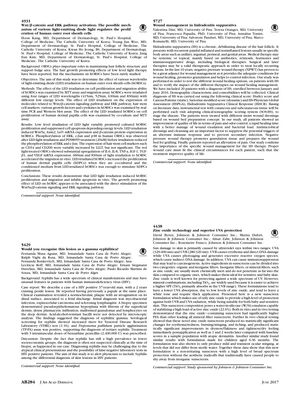Wnt/β-Catenin and ERK Pathway Activation: The Possible Mechanism of Various LED Light Regulating the Proliferation of Human Outer Root Sheath Cells
May 2017
in “
Journal of The American Academy of Dermatology
”
LED light human outer root sheath cells hORSCs Wnt/β-catenin ERK signaling pathway hair stem cell markers CD34 CD200 IL-6 IL-8 TNF-α IGF-1 TGF-β1 VEGF human dermal papilla cells hDPCs apoptosis proliferation migration Wnt5a Axin2 Lef1 β-catenin phosphorylation c-Jun p38 PD98059 red light 660nm light 830nm light ERK pathway

TLDR LED light helps human hair root cells grow and move by activating certain cell pathways.
The document reports a study investigating the effects of various wavelengths of LED light on human outer root sheath cells (hORSCs), which are important for hair follicle structure and support. The study aimed to determine how LED light affects the proliferation and migration of hORSCs. The researchers used MTT and migration assays to examine cell proliferation and migration, and real-time PCR and Western blot assays to analyze the expression of molecules related to the Wnt/β-catenin and ERK signaling pathways, as well as hair stem cell markers and various growth factors and cytokines. The results showed that low-level LED light irradiation promoted hORSC proliferation, suppressed apoptosis, and induced the expression of Wnt5a, Axin2, Lef1 mRNA, and β-catenin protein. Additionally, phosphorylation of ERK, c-Jun, and p38 was observed after irradiation, and treatment with PD98059 reduced the phosphorylation of ERK and c-Jun. The expression of hair stem cell markers CD34 and CD200 was increased, although not significantly. Red light treatment significantly upregulated the expression of IL-6, IL-8, TNF-α, IGF-1, TGF-β1, and VEGF mRNA. Irradiation with 660nm and 830nm light accelerated hORSC migration in vitro, and LED-irradiated hORSCs increased the proliferation of human dermal papilla cells (hDPCs) in co-culture. The study concludes that LED light irradiation stimulates hORSC proliferation and migration and inhibits apoptosis through the activation of the Wnt/β-catenin and ERK signaling pathways. No commercial support was identified for this study.
